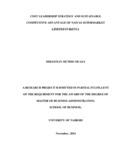| dc.description.abstract | The retail chain industry is undergoing a fundamental structural shift. For many, survival
of the retail chain business depends on their ability to develop new business models to
enable them adapt to the ever changing environment. The purpose of strategy according
to Ramaswamy and Namakumari (1996) is to exploit the unique advantages of the
organization in facing the challenges of the environment. The successful corporations
make their strategic priority to build their core competencies and long term competitive
advantages. To acquire competitive advantage in any market, a firm needs to be able to
deliver a given set of customer benefits at lower costs than competitors, or provide
customers with a bundle of benefits its rivals cannot match. To realize the potential that
core competencies create, a company must also have the imagination to envision markets
that do not yet exist and the ability to stake them out ahead of competition (Hamel and
Prahalad 1991; Porter 1980). Businesses become successful when they posses some
advantage relative to their competitors (Pearce and Robinson, 1997). This paper seeks to
examine the effects of cost leadership strategy and sustainable competitive advantage of
Naivas supermarket in Kenya. The increasing global nature of competition requires that
the firm utilizes all of its valuable resources in order to survive and succeed. Therefore,
Naivas as a retail chain needs to identify and build on the cost drivers and key success
factors that are sustainable and will set it above other supermarkets in the industry as
competition intensifies. The study was carried out through a case study design of Naivas
Supermarket where primary data was collected using an interview guide and secondary
data obtained from the company website, Industry periodicals and company publications.
Personal interviews were done with Naivas Supermarket Human Resource Manager,
Operations Manager, Purchasing & Supplies Manager, ICT Manager, Business
Development & Marketing Manager and Finance Manager at the company‟s head office
in Nairobi‟s Sameer Industrial park using an interview guide. Content analysis technique
was used to analyze the data. The study found that Naivas supermarket had to a large
extend applied the cost leadership strategy on its operations by defining its low and
middle income market niche, but more needs to be done to enhance the efficiency of the
cost leadership business model. The study further established that the retail chain
business environment is moderately changing and is characterized by dominant privately
owned firms which inform the kind of competitive strategies adopted. It was found that
for cost leadership strategy to be effective, high investment in technology, customer
focus, selling a wide range of products, improving employee morale, effective
management and good relations with suppliers were all key success factors in actualizing
the strategy to ensure a sustainable competitive advantage. The study also established as
critical for senior managers to undergo occasional training and scenario exposures to be
up to speed with dynamic industry environmental factors. The study recommended
further research could be carried out on cost leadership and differentiation strategies in
the retail chain business owing parallel strategies often adopted. Additionally there is
need to explore on the challenges of applying cost leadership in a controlled market
economy. | en_US |

